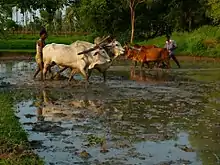
Puddling is the tillage of rice paddies while flooded, an ancient practice that is used to prepare for rice cultivation. Historically, this has been accomplished by dragging a weighted harrow across a flooded paddy field behind a buffalo or ox, and is now accomplished using mechanized approaches, often using a two-wheel tractor.[1]
Puddling reduces the percolation rates of water by churning the clay particles and making them close many of the soil pores.[2] Puddling also has the consequences of converting soils into "...a structurally more or less homogeneous mass of ultimate particles.” [3] Combined with good agricultural practices puddling has proven to be sustainable for many rice-rice systems. Yet the loss of aggregates in systems other than rice-rice (rice-maize, rice-wheat, etc) proves to be much less sustainable resulting in loss of soil health and degradation. THis has led to the development alternative soil management systems where the minimum soil disturbance via minimum tillage, strip-till and no-till practices can not only stop a soil's degradation but also generally improve the soil's health ( regenerative agriculture).
References
- ↑ "Puddling - an overview | ScienceDirect Topics".
- ↑ Lu, Jun; Ookawa, Taiichiro; Hirasawa, Tadashi (2000). "The effects of irrigation regimes on the water use, dry matter production and physiological responses of paddy rice". Plant and Soil. 223: 209–218. doi:10.1023/A:1004898504550. S2CID 25108715.
- ↑ Buehrer, T.F., and Rose, M.S., 1943. Studies in soil structure. V. Bound water in normal and puddled soils, Ariz. Agric. Exp. Sta. Tech. Bull, No. 100, pp. 155–218.